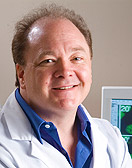News
Microbiologist identifies HPV drug target
-
 Print
Print -
 Comments
(1)
Comments
(1)
-

“Currently, no antiviral drugs exist that act directly against HPV.”
Among viruses, human papilloma virus (HPV) stands out: With more than 180 distinct isotypes, or variations, catalogued to date, it presents an extremely difficult target for broad-range treatments. And while the HPV vaccine provides protection against the most common HPV infections, it only covers four of the 180-plus isotypes.
But now a UB microbiologist has identified a protein interaction that could present the first viable, broad-range HPV drug target. This protein sequence in the viral DNA synthesis system is not only necessary for HPV synthesis, it is highly conserved between all HPV isotypes.
To find out if this protein interaction might be the basis of a drug that would work against all HPV isotypes, the National Institute of Allergy and Infectious Diseases of the National Institutes of Health has awarded a $1.65 million grant to Thomas Melendy, associate professor in the departments of Microbiology and Immunology, and Biochemistry in the School of Medicine and Biomedical Sciences.
“Currently, no antiviral drugs exist that act directly against HPV,” says Melendy, whose laboratory is a world leader in identifying critical interactions between the HPV proteins and human proteins that the virus uses to duplicate viral DNA. His work explains why HPV, unlike other DNA viruses, integrates so readily into the genome of human cells.
The target Melendy and his colleagues have identified is E1, a protein found in all HPV isotypes.
“E1 is a protein encoded for in the viral genome that interacts with human-DNA synthesis proteins and enzymes,” explains Melendy. “It is found in all 180-plus HPV isotypes and it essentially ‘reprograms’ our human DNA synthesis machinery to start synthesizing HPV genomes once our cells are infected.”
In particular, Melendy has been studying a protein-protein interaction called E1-Topol in which E1 interacts with the human enzyme Topol (Topoisomerase I).
In 2010, Melendy identified individual amino acids within the HPV E1 protein that he suspected were critical for the interactions with Topol. His lab created a mutation of E1 that altered a single amino acid within this conserved domain. Melendy’s colleague, Jacques-Archambault, director of the Institut de Recherches Cliniques de Montreal, tested this mutation in a cell-culture HPV DNA synthesis system he had developed.
“The result provided the proof-of-principle we were seeking,” says Melendy, “demonstrating, as I had predicted, that this E1 mutant was dramatically compromised for HPV DNA synthesis, thus proving that if we could find a way to interfere with this E1-Topol interaction, it should prevent the HPV virus from reproducing.”
It turned out that interaction domain on E1 is one of the most conserved protein sequences across all HPV isotypes. “That suggested that if we can find a way to interfere with this interaction, we could affect all HPV isotypes and not just some,” says Melendy.
The new grant funds research designed to further analyze this interaction in order to find out how best to attack it. In addition to Melendy, other investigators on the grant include Archambault and Vivian Cody, principal scientist at Hauptman-Woodward Medical Research Institute and UB professor of structural biology, who will attempt to co-crystallize Topol with the domain of E1 that interacts with Topol in order to visualize the interaction at the atomic level.
All of this information then will be used to develop a more refined series of small molecules designed to interfere with the E1-Topol interaction, with the ultimate goal of developing a broad-range, anti-HPV drug.
“For individuals with persistent HPV infections, which has recently been found to be a particular problem among African-American women, for example, a treatment that works against an ongoing HPV infection and that acts against all HPV isotypes is exactly what is needed,” says Melendy.

Reader Comments
Reginald Finley Sr says:
I hope some practical applications will result from this research. I will be watching intently its progression, for many varied personal reasons.
Posted by Reginald Finley Sr, UB Grad Student - Science and The Public, 06/03/12